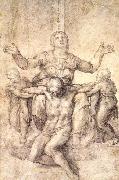China al por mayor de Marco de Oleo |
|||||||||||

|
|||||||||||
|
|
|
||||||||||||||
|
Michelangelo Buonarroti
b Caprese 1475 d Rome 1564 |
||||||||||||||
|
|
||||||||||||||
|
||||||||||||||
|
|
||||||||||||||
| Michelangelo Buonarroti
b Caprese 1475 d Rome 1564 1538 Chalk Isabella Stewart Gardner Museum, Boston In 1538, three years before the completion of the Last Judgment, Michelangelo had met Vittoria Colonna. She belonged to the circle of Juan Valdes, who was striving towards an internal reform of the Catholic Church. To put it very simply, one can say that the main conviction of this theological trend was the idea of the utmost need of faith, as opposed to good deeds or sacraments, because, in the last resort, it is only divine grace which is all-powerful. These almost protestant beliefs could not conquer, or in any way change, Michelangelo because too much of his work would have had to be denied. However, they must have to some extent disrupted his firm belief, as he had expressed it in his works, that by creating perfect physical beauty he had represented the essence of the supernatural and of the divine. It is true, however, that he felt the need for divine grace, and, from this point onwards, this had great bearing on his creative life. We find evidence of this in a drawing of the Piete made for Vittoria Colonna. When compared with the 1499 Piete we see clearly that the main objective is the thought of the Compassionate Christ and of the Redemption through Christ's Blood. The work turns openly towards the onlooker to admonish him, drawing his attention to the sacrifice of Golgotha. Artist: MICHELANGELO Buonarroti Title: Study for the Colonna Piete Date: 1501-1550 Italian , graphics : study |
||||||||||||||
|
Related Paintings to Michelangelo Buonarroti :. |
||||||||||||||
|
|
||||||||||||||
|
|
||||||||||||||
|
CONTACTE EEUU |







